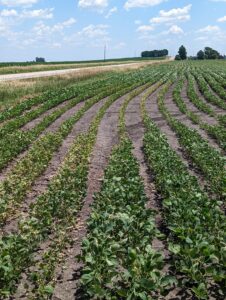Illinois Crops Update 7/1/2022
Each week, I put out a request to crops educators and specialists from the University of Illinois to compile an update to share with the entire state. We hope you find this information useful. If you have any questions or suggestions about the format or any feedback in general about these updates, please email me (harbach2@illinois.edu).
Emerson Nafziger, Agronomy Extension Specialist, University of Illinois
Although rain fell in many places in central and northern Illinois last weekend (June 25-26) this week’s drought map shows even more of Illinois in “abnormally dry” (D0) or “moderate drought (D1) than a week earlier. This is not surprising, given that crops are removing water more water each day than they did when they were smaller, and evaporation rates have remained high. This means that an inch or more of water can disappear from the soil within three or four days, leaving plants to again struggle to extract water from the soil. Both corn and soybean plants responded quickly to rain by adding height and leaf area, but they remain smaller in many fields than they would normally be this long after planting. If rains return in the coming days, soybeans have the potential to recover most of their yield potential. That may not be the case for corn that’s been showing afternoon stress daily and is within 10 days to two weeks of pollination.
Talon Becker, Commercial Agriculture Extension Educator, South-Central IL
Much of the south-central IL region received much-needed rain this past weekend. Wheat harvest is completed in most areas, with most double-crop beans planted this week. The earliest planted corn in the area is around V10 and will likely start to show tassel in the next couple of weeks. Full-season soybeans are largely in the V3-V4 stage, with maybe a few early planted fields a bit further along.
Doug Gucker, Local Foods and Small Farms Extension Educator, Central IL
This part of Illinois is either “abnormally dry” or in “moderate drought” according to the US Drought Monitor. The crops are still looking good considering the dry conditions. Corn is V5 – V9 stage and most soybean fields are at the R1 stage. Wheat harvest is underway, second cutting hay is in progress and most post-emergence herbicide applications are completed. Japanese beetles are being seen in soybean fields. The rain storms that have occurred have caused crop damage in scattered fields across this part of Illinois.

Phillip Alberti, Commercial Agriculture Extension Educator, Northern IL
Like most of the state, it has been hot and very dry here in NW Illinois. With the drought monitor showing abnormally dry across the region, a quick trip east towards Joliet showed more of the same.
With corn approaching V5 and soybeans around V4, the rain that came to much of northern Illinois last week could not have come at a better time. Despite rainfall totals being spotty, as they normally are this time of year, the accumulation provided much-needed relief to the stressed crops in the region.
Earlier planted corn and beans appear to be in better shape, as they are more likely to reach any subsoil moisture that remains. Regardless corn leaves are still rolling in the afternoon and growth is slower than we would like it to be.
With high temperatures and dry conditions stretching over the next few days, let’s hope we can catch another “million-dollar rain” (or two) early next week.


Nathan Johanning, Commercial Agriculture Extension Educator, Southwestern IL
Late last week we finally got a small break in our dry conditions with most of the area getting 0.6 to 0.8 inches of rain. This was coupled with a cool down to the low 80s for the weekend so crops had the moisture and a little less heat stress on crops. Temperatures and humidity have inched up over the week now back to the mid-90s for highs. Crops are starting to show just a little stress by now, especially on droughty hillsides but nothing like prior to the rain. The earliest double crop soybeans are just starting to emerge and take off.
Chelsea Harbach, Commercial Agriculture Extension Educator, Northwestern IL
To my surprise, what was forecasted as a 0.4-inch weekend rain in Knox County turned into closer to 3 inches! Sadly, the rain event appeared to be quite spotty, with some areas in western Illinois getting smaller amounts where they needed it most. Later planted soybeans are still struggling, especially where weekend rain accumulation was smaller. On top of that, I’ve seen a lot of (what appears to me as) herbicide damage on a lot of the later-planted soybean fields, too (see image below). These fields that were dinged by drift really need an extra touch of rain to help them come out of the damage. Corn overall is looking good, especially, as expected, the earlier planting dates. As we approach the time of the season when fungicide applications are starting, I ask that you please consider fungicide resistance management in your fields. I wrote a blog on this recently, posted over on Hill & Furrow.






